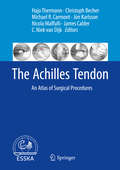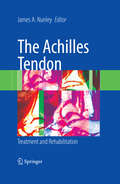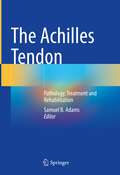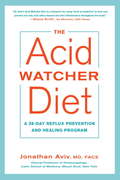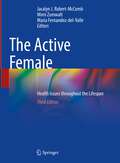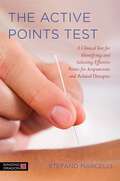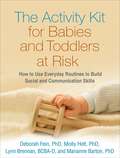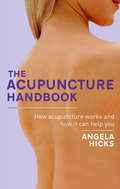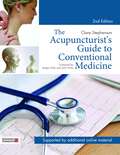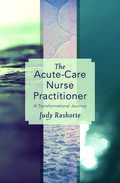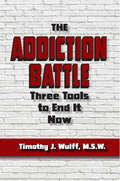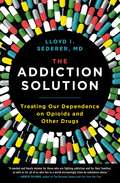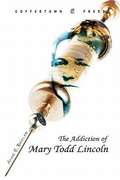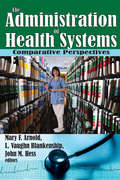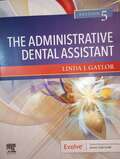- Table View
- List View
The Accidental System
by Michael D. ReaganAn insightful policy study that shows that in the American political context, health care is neither exclusively a public right nor a private privilege.
The Accidental Veterinarian: Tales from a Pet Practice
by Philipp Schott&“For all animal lovers ... Few books ... approach the combination of fine writing, radical honesty, and endless optimism found [in these] veterinary tales.&” (Booklist, starred review) With insight and humor, Dr. Philipp Schott shares tales from the unlikely path he took into his career as a veterinarian and anecdotes from his successful small-animal clinic. Dr. Schott brings to his writing the benefit of many years of expertise. Wisdom he imparts on readers includes the best way to give your cat a pill, how to prevent your very handy dog from opening a fridge, and how to handle your fish when it has half-swallowed another. Through these and other experiences, Dr. Schott also learned that veterinary medicine is as much, if not more, about the people as it is the animals. And he will have you laughing and crying as you embark on this journey of discovery with him. &“Filled with heartwarming stories any animal lover will enjoy. It&’s informative and entertaining, much like our pets themselves!&” ― eresa Rhyne, author of the #1 New York Times bestseller The Dog Lived (and So Will I) &“Who amongst us animal lovers hasn&’t fantasized being a vet? Well, read Philipp Schott&’s highly entertaining and informative book and learn exactly what you&’d be in for―all the poignancy, hilarity, and plain hard work. You may decide to keep your day job, but you&’ll be a much better animal companion for having picked up the many insider tips Schott imparts.&” ―Barbara Gowdy, award-winning author of The White Bone and Helpless
The Achilles Tendon
by James Calder Nicola Maffulli C. Niek van Dijk Jón Karlsson Hajo Thermann Christoph Becher Michael R. CarmontThis book, written by leading experts in the field, is a comprehensive guide to the best available techniques in Achilles tendon surgery. Each surgical procedure is described step by step, covering all of the approaches employed for the most common and important Achilles tendon pathologies. The clear descriptions are complemented by superb drawings prepared by a medical artist on the basis of photographs supplied by the authors. Pearls and possible pitfalls are identified to ensure optimal outcomes for patients. The book is the outcome of a collaboration among international Achilles tendon experts - the Achilles Tendon Study Group - that has already resulted in four other books on current concepts relating to the Achilles tendon. Like these previous volumes, The Achilles Tendon - An Atlas of Surgical Procedures is based on the highest level of evidence and expertise. It will be invaluable for orthopaedic surgeons, trauma surgeons, and residents, assisting them in their daily clinical work.
The Achilles Tendon
by James A. NunleyThis techniques-oriented text is a comprehensive guide to managing Achilles tendon problems. Readers learn the latest less invasive and nonoperative treatment approaches, in addition to traditional treatments, from internationally renowned contributors. Introductory chapters provide essential background on basic anatomy, physiology, and pathomechanics. Subsequent sections cover the spectrum of Achilles tendon injuries. Acute and chronic conditions are addressed, as well as problems specific to both adolescents and adults. The book also takes a practical approach to sports training in relation to the role of the Achilles. Rehabilitation is highlighted with an emphasis on quicker return to play. Case studies tie the book together and aid with the ready application of concepts to daily practice.
The Achilles Tendon: Pathology, Treatment and Rehabilitation
by Samuel B. AdamsPathology of the Achilles tendon is one of the most commonly written about topics in foot and ankle surgery, yet there is no clear consensus on the management of these injuries; in addition, pathologic aspects of the Achilles tendon are not well understood. This up-to-date resource addresses all aspects of Achilles tendon pathology, management, rehabilitation and complications, including novel aspects of Achilles tendon treatment as well as more detail on operative techniques for Achilles tendon surgery. Sensibly divided into four thematic sections, part I presents general considerations such as anatomy and pathology, the physical exam and imaging modalities, and patient-reported outcomes. The following sections describe current management strategies for acute and chronic injuries and complications, respectively. Both nonoperative and operative techniques are highlighted, from minimally invasive techniques to tendinoscopy and open debridementand biological augmentation. Generous intraoperative photos and figures enhance the presentation, and operative algorithms are clearly elucidated. Bringing together the latest in the diagnosis and management of these common injuries, The Achilles Tendon will be a valuable reference for orthopedic foot and ankle surgeons, sports medicine surgeons, podiatrists and fellows and residents in these areas.
The Acid Watcher Diet: A 28-Day Reflux Prevention and Healing Program
by Jonathan AvivDo you suffer from abdominal bloating; a chronic, nagging cough or sore throat; post-nasal drip; a feeling of a lump in the back of your throat; allergies; or a shortness of breath? If so, odds are that you are experiencing acid reflux without recognizing the silent symptoms. Even without the presence of heartburn or indigestion, more than 60 million people are suffering from acid-related disorders that are undetected or untreated--and leading to long-term health problems, including the rapid rise of esophageal cancer. Since there are no outward signs of acid damage and the typical symptoms might not be recognized, until now you might not have known how pervasive acid reflux is or that you have it. In The Acid Watcher Diet, Dr. Jonathan Aviv, one of the leading authorities on the diagnosis and treatment of acid reflux disease, helps readers identify those silent symptoms and provides his proven solution for reducing whole-body acid damage quickly and easily. His 28-day program includes a two-phase eating plan, menu guide, and recipes and works to immediately neutralize acid, stabilize pH levels, and relieve the inflammation at the root of acid reflux. Dr. Aviv's Power of Five rule will help readers discover the key foods that offer fast relief, and his Daily Six will reveal the foods to avoid (onion, tomato, citrus, and more). The Acid Watcher Diet's groundbreaking program is just what millions of readers need to reduce acid and balance their bodies and minds for optimal health.
The Actin Cytoskeleton and Bacterial Infection
by Hans Georg MannherzThis volume describes the mechanisms which bacteria have created to secure their survival, proliferation and dissemination by subverting the actin cytoskeleton of host cells. Bacteria have developed a veritable arsenal of toxins, effector proteins and virulence factors that allow them to modify the properties of the intracellular actin cytoskeleton for their own purposes. Bacterial factors either modify actin directly as the main component of this part of the cytoskeleton or functionally subvert regulatory or signalling proteins terminating at the actin cytoskeleton. In short, this volume provides an overview of the various tricks bacteria have evolved to "act on actin" in order to hijack this essential host cell component for their own needs. As such, it will be of interest to scientists from many fields, as well as clinicians whose work involves infectious diseases.
The Active Female: Health Issues throughout the Lifespan
by Mimi Zumwalt Jacalyn J. Robert-McComb Maria Fernandez-del-ValleNow in a revised and expanded third edition, the aims of The Active Female are threefold: first, to increase the awareness of wellness and fitness issues for active females and their family members; second, to provide an avenue for medical practitioners, allied health professionals, health educators/providers, and certified individuals in sports medicine/athletics to gain critical, updated knowledge of a field specific to active females; and third, to introduce the concept of obesity as a growing health concern even for normal weight individuals. Part I of the book offers a foundation for understanding the interrelationships between female physiology, body image and other psychological issues, the female reproductive cycle, and the musculoskeletal anatomy and physiology of females that makes their health risks and concerns unique. In Part II, the concepts of eating disorders from a global perspective and the health disparities and inequities in women’s health are discussed in detail. Part III describes the prevention and management of common musculoskeletal injuries in active females across the lifespan, including the management of osteoporosis. Appropriate exercise and nutritional guidelines and recommendations for active females are discussed in detail in Parts IV and V. Part VI is a new addition to the book and highlights the obesity epidemic and co-morbid diseases associated with obesity even for normal weight obese individuals. Each chapter is bookended by clear learning objectives and review questions for additional pedagogical appeal. An invaluable addition to the literature, The Active Female: Health Issues throughout the Lifespan, 3e will be of great interest to all clinicians and allied health care professionals concerned with women’s health and related issues, from sports medicine and family practitioners to endocrinologists, gynecologists and orthopedic surgeons.
The Active Points Test: A Clinical Test for Identifying and Selecting Effective Points for Acupuncture and Related Therapies
by Stefano MarcelliThe Active Points Test is a clinical instrument for identifying and selecting the points on the skin that are most effective for treatment. These points may be close to the seat of the disease, for example on the shoulder for periarthritis, or far away, for example on the ear or head for stomach pain or a cough. Drawing on principles from TCM and Western medicine, Dr Stefano Marcelli sets out the theory of the approach and offers detailed guidance on how to carry out the test and how to interpret the results, as well as explaining how the test can be used in different therapies. The test is based on the discovery that a patient experiencing an ongoing symptom can be made aware of the capacity of a few points on the skin to treat his or her discomfort. The test involves stimulating the skin to the appropriate degree whilst asking the patient to identify whether there is any change in the symptom he or she is suffering, and can be used to treat a wide range of symptoms, from articular pain to migraine, tachycardia, asthenia and depression. Published for the first time in 1995, this substantially updated edition contains the most recent supporting evidence and many new explanatory diagrams and photographs. Providing a comprehensive and effective system for point selection, this is essential reading for practitioners and students of acupuncture and related reflex and manual therapies, including massage, tuina, Shiatsu and Rolfing.
The Activity Kit for Babies and Toddlers at Risk
by Molly Helt Deborah Fein Lynn Brennan Marianne BartonSuspecting that your baby or toddler may have autism spectrum disorder or another developmental delay can be scary and overwhelming. But there is a lot you can do to help, even while waiting for an evaluation or early intervention. With the right tools, everyday tasks can be terrific opportunities for building critical social and communication skills. Start at the kitchen table, bathtub, or shopping cart! In this easy-to-navigate guide, leading experts present more than 100 games and activities designed to support development in children from birth to age 3. Your child's daily routines are transformed into learning opportunities that promote crucial abilities, like how to imitate others or use simple hand gestures to convey wants and needs. As a parent, you are the most important person in your child's life. Now you can be the best teacher, too.
The Acupuncture Handbook: How Acupuncture Works and How it Can Help You
by Angela HicksAcupuncture is one of the most popular and widely accepted complementary therapies available to the general public. And yet many of us know little about it, what it can be used for, and how it works. This book explains: * What it feels like to have treatment* How acupuncture works* How acupuncture helps to balance your energy and strengthen your immune system* How it can successfully treat a wide variety of ailments, from panic attacks to hot flushes, asthma, joint pains and the common cold* Which of the 'Five Element' types you are and how this relates to your health* How acupuncture can be used safely and effectively to treat pregnant women, children, and animals* How to find the right practitioner. Self-help information and questionnaires are also included to enable you to discover more about your diagnosis.
The Acupuncture Handbook: How acupuncture works and how it can help you
by Angela HicksAcupuncture is one of the most popular and widely accepted complementary therapies available to the general public. And yet many of us know little about it, what it can be used for, and how it works. This book explains: * What it feels like to have treatment* How acupuncture works* How acupuncture helps to balance your energy and strengthen your immune system* How it can successfully treat a wide variety of ailments, from panic attacks to hot flushes, asthma, joint pains and the common cold* Which of the 'Five Element' types you are and how this relates to your health* How acupuncture can be used safely and effectively to treat pregnant women, children, and animals* How to find the right practitioner. Self-help information and questionnaires are also included to enable you to discover more about your diagnosis.
The Acupuncturist's Guide to Conventional Medicine, Second Edition
by Clare StephensonOffering a systematic comparative approach to Western and Eastern medicine, this unique textbook enables students and practitioners of Chinese Medicine to develop a core understanding of conventional medical language and treatments. Acupuncture practitioners increasingly find themselves working alongside Western healthcare professionals. Now in its second edition, this book is a guide to conventional medical diagnoses, symptoms and treatments, and using examples drawn from the author's experience and knowledge of TCM it encourages reflection on how these diagnoses may be interpreted from a more holistic medical perspective. It includes introductory sections on physiology, pathology and pharmacology, chapters devoted to the physiological systems of the body and the conventional approach to the treatment of diseases that can affect them, and information on dealing with patients in practice. Accompanying online material, including self-testing questions and answers and checklists for revision, is available for those wishing to use the text for systematic study.
The Acute Knee: A Handbook for Sports Medicine Physicians
by Mark F. ShermanThis handbook presents a concise, practical approach to the physical examination and diagnosis of acute injuries of the knee. While radiological diagnostic tools like CT and MRI are important tools for orthopedic and sports medicine injuries, the skills of history taking and an accurate physical exam are no less important in educated decision-making when it comes to injury management. The goal of this book is to make it easier for a beginning knee practitioner to take an educated history and then perform a thorough physical examination. This will invariably steer them to the course of the correct diagnosis. The focus here is on a consistent and thorough examination, including taking a full history of the injury, utilizing common physical tests, and limiting differential diagnoses. To this end, the book opens with a review of these general considerations. Subsequent chapters discuss these considerations across a number of acute knee injuries to the patella, ACL, MCL, PCL, meniscus, and multiligamentous and extensor mechanism injuries and conditions. Additional chapters describe osteochondral injuries and mimickers such as PVNS and tumors. Video clips demonstrating examination techniques are included throughout the text. While The Acute Knee is aimed primarily at younger practitioners, it is an excellent resource for any orthopedic surgeon or sports medicine physicians looking to refamiliarize themselves with the "lost art" of physical examination for the acute knee.
The Acute Management of Surgical Disease
by Martin D. Zielinski Oscar GuillamondeguiEmergency General Surgery has become a cornerstone of Acute Care Surgery over the past decade. Once the scope of community general surgeons, the growing complexity of patients with acute surgical diseases has increasingly driven their care to tertiary referral centers. The aging population confounds this problem further as these patients present with more complex comorbidities, life-threatening physiology, and progressively severe anatomic disease severity. To ensure better outcomes, the practice has evolved to focus on evidence-based practice management guidelines in order to standardize care and optimize outcomes.The purpose of this text is to be a comprehensive volume for patients with acute surgical diseases. There will be three sections, each comprised of multiple chapters. The first section will be a comprehensive analysis of the background of Emergency General Surgery. The goal of this section will be to provide the reader background into the acute surgical practice and to introduce the reader to the important concepts discussed in the remainder of the textbook. The second section will be the largest and will discuss specific acute surgical diseases. Individual chapters will outline the diagnostic approach, current treatment standards, operative approaches, and expected outcomes with an emphasis on practice management guideline implementation into practice. As acute surgical diseases and surgical critical care are integral to each other, the last section will be Critical Care for the Acute Care Surgeon. These topics will focus on the critical care concepts essential to surgeons who care for acute diseases.This comprehensive text is targeted to any surgeon who takes emergency call for any of the listed diseases including community and referral general and vascular surgeons. In addition, this would be an excellent resource for all general surgery residents. Lastly, this would also serve as a resource to intensivists who care for acute surgical patients.
The Acute-Care Nurse Practitioner: A Transformational Journey
by Judy RashotteFrom the moment it was first proposed, the role of the nurse practitioner has been steeped in controversy. In the fields of both nursing and medicine, the idea that a nurse practitioner can, to some degree, serve as a replacement for the physician has sparked heated debates. Perhaps for that reason, despite the progress of the nurse practitioner movement, NPs have been reluctant to speak about themselves and their work, and their own vision of their role has thus remained largely invisible. Current research is dominated by instrumental and economic modes of discourse and tends to focus on the clinical activities associated with the role. Although information about demographics, educational preparation, position titles, reporting relationships, and costs of care contribute to our understanding, what was missing was an exploration of the lived experience of the nurse practitioner, as a means to deepen that understanding as well as our appreciation for their role. The Acute-Care Nurse Practitioner is based on in-depth interviews with twenty-six nurse practitioners working in acute-care settings within tertiary-care institutions all across Canada. Employing a hermeneutic approach, Rashotte explores the perspectives from which NPs view their reality as they undergo a transformational journey of becoming—a journey that is directed both outward, into the world, and inward, into the self. We learn how, in their struggle to engage in a meaningful practice that fulfills their goals as nurses, their purpose was hindered or achieved. In large part, the story unfolds in the voices of the NPs themselves, but their words are complemented by descriptive passages and excerpts of poetry that construct an animated and powerful commentary on their journey. Poised between two worlds, NPs make a significant contribution to the work of their colleagues and to the care of patients and families. The Acute-Care Nurse Practitioner offers an experiential alternative to conventional discourse surrounding this health care provider’s role.
The Adam Experiment
by Geoffrey S. SimmonsCortney is both scientist and mother in a dramatic experiment that turns into nine months of terror when the Alien arrives - the first human child conceived and born in space!
The Addiction Battle: Three Tools to End It Now
by Timothy J Wulff Timothy J. Wulff, M.S.W.Is every day a challenge as you wage your personal battle against addiction? If you've fallen into the addiction trap, you are not alone. It is estimated that one out of ten Americans is struggling with addiction. Author Timothy Wulff, M.S.W., is an addiction therapist who has spent more than a decade successfully treating individuals addicted to drugs and alcohol. To identify the source of addiction, Wulff focuses on beliefs about one's self that develop early in life and that eventually obscure the strong and positive true self, increasing susceptibility to addiction. In The Addiction Battle, Wulff will help you discover where your greatest strengths are buried and teach you how to use their hidden power to overcome addiction. Wulff will teach you how to redefine the terms anger, selfishness, and troublemaking, and make them key tools in shaping your actions from a new healthy perspective:•• Anger—It's a powerful emotion that can be used constructively to protect yourself.•• Selfishness—Healthy selfishness is good self-care. Without it, addiction continues.•• Troublemaking—the opposite of pleasing others, troublemaking helps you stand up for your own feelings, needs, and desires.Learning to use these tools, which are already part of you, will enable you to reclaim these inner strengths. Through the book's practical and sensitive pages, Wulff gives you a way to begin your life anew and triumph over addiction.
The Addiction Solution: Treating Our Dependence on Opioids and Other Drugs
by Lloyd SedererA groundbreaking examination of addiction from a psychiatrist and public health doctor, offering practical, proven solutions for individuals, families, and communities dealing with substance use and abuse.Written with warmth, accessibility, and vast authority, The Addiction Solution is a practical guide through the world of drug use and abuse and addiction treatment. Here, Lloyd I. Sederer, MD, brings together scientific and clinical knowledge, policy suggestions, and case studies to describe our current drug crisis and establish a clear path forward to recovery and health. In a time when so many people are affected by the addiction epidemic, when 142 people die of overdoses every day in the United States, principally from opioids, Sederer’s decades of wisdom and clinical experience are needed more than ever before. With a timely focus on opioids, Sederer takes us through the proven essentials of addiction treatment and explains why so many of our current policies, like the lingering remnants of the War on Drugs, fail to help drug users, their families, and their wider communities. He identifies a key insight, often overlooked in popular and professional writing about addiction and its treatment: namely, that people who use drugs do so to meet specific needs, and that drugs may be the best solution those people currently have. Writing with generosity and empathy about the many Americans who use illicit and prescribed substances, Sederer lays out specific, evidence-based, researched solutions to the prevention and problems of drug use, including exercise, medications, therapy, recovery programs, and community services. In this challenging time, The Addiction Solution provides practical help, comfort, and hope.
The Addiction of Mary Todd Lincoln
by Anne E. BeidlerMary Todd Lincoln, wife of the president we have immortalized, has always been difficult for us to understand. She could appear poised and brilliant one moment yet rude and ugly the next. Sometimes competent and strong, able to entertain dignitaries from around the world, at other times she appeared dependent and weak. At times she seemed utterly beside herself with sobbing and screaming. Historians have mostly avoided saying very much about Mary Todd Lincoln except in reference to her husband, Abraham. To many it would seem that Mary Todd Lincoln is still an embarrassment in the tragic story of her martyred husband. But Mary Todd Lincoln lived her own tragic story even before Abraham was murdered. She was an addict, addicted to the opiates she needed for her migraine headaches. Seeing Mary Todd Lincoln as an addict helps us understand her and give her the compassion and admiration she deserves. In her time there had been no courageous First Lady like Betty Ford to help people understand the power of addiction. There was no treatment center. In Mary Todd Lincoln's time there were many addicts at all levels of society, as there are now, but it was a more socially acceptable condition for men to have than for women. More importantly, addiction was not very well understood, and it was often mistreated. Because Mary Todd Lincoln's only surviving son, Robert Lincoln, made a great effort to protect his mother and his family from journalists and historians, he intentionally destroyed most of Mary Todd Lincoln's medical records and many of her letters. What he could not destroy, however, is the record of Mary Todd Lincoln's pain and the record of how she behaved while living with this pain. In The Addiction of Mary Todd Lincoln, we can see clearly, for the first time, what Mary Todd Lincoln had to live with and the courage it took for her to carry on.
The Addictive Behaviors
by Barry Stimmel Howard J ShafferThoroughly examines the natural history and social etiology of addictive behaviors.
The Adenosine Receptors (The Receptors #34)
by Pier Andrea Borea Katia Varani Stefania Gessi Stefania Merighi Fabrizio VincenziThis book traces the history of adenosine receptor research from molecular biology to medicinal chemistry to behavior, including their implications in disease and potential strategies as therapeutic targets. It provides the reader with a comprehensive overview of the adenosine receptors that includes information on all subtypes - A1, A2A, A2B and A3. Aspects addressed include the most up to date information on their functional distribution in the nervous and peripheral systems, behavioral roles in inflammation, cancer, pain and neurological diseases such as Huntington’s disease, Epilepsy, Parkinson’s disease and Alzheimer’s disease.
The Adenosinergic System
by Micaela Morelli Nicola Simola Jadwiga WardasAdenosine A2A receptor antagonists have shown great promise in the treatment of Parkinson's Disease and alleviation of symptoms. This book addresses various aspects of this class of drugs from their chemical development to their clinical use. Among the many insightful chapters contained in this book, there are three unique reviews that have not previously been published in any format: (1) a history of istradefylline, the first A2A antagonist approved for treatment of Parkinson's Disease, (2) an overview of neuroimaging studies in human death and disease and (3) a study of urate as a possible biomarker and neuroprotectant.
The Administration of Health Systems: Comparative Perspectives
by Martin HarrisonIn the late 1960s, American society entered a period of rapidly accelerating social change. Certainty that U.S. vast scientific and technical capability would be able to find solutions to all problems began to turn to concern, as organizational efforts were unable to keep pace with new developments in a variety of areas.The health field, with its focus on the well-being of individuals, felt the impact of these changes particularly strongly. Medicines became more focused on isolated health practices, as the patient's needs were attended to within groups of unrelated biological systems. The emerging thought represented in this collection pushes for the perception of health as a right rather than as something to be earned. It argues that deprivation of life-saving and life-fulfilling opportunities to any populations should not be tolerated. The editors also demand more awareness of the implications of isolated health activities and make the case for a comprehensive total health care system. Health is no longer just a biological function; quality of life is also a concern.First published in 1971 by administrators of health agencies, teachers, and health personnel, this work presents perspectives on problems and interpretations of forces and issues that are of continuing importance to health administrators. The emphasis on the need to focus on the whole patient rather than just their illness, and on providing them with a good life, not just a disease free one, is still as valid today as it was when this volume was initially published.
The Administrative Dental Assistant
by Linda J. GaylorMaster critical thinking, effective communication, and common tasks such as scheduling, record keeping, and insurance processing with The Administrative Dental Assistant, 5th Edition. This complete learning package is used to train dental assistants in a wide variety of settings ― from traditional classroom programs to on-the-job training to use as a review tool for practitioners ― to become competent administrative assistants in a dental office. As it guides you through the functions of today’s dental business office, you will learn how to organize tasks, complete procedures, and acquire a professional outlook toward dentistry along the way. Supplemented with online study tools, a companion workbook (sold separately), and access to Dentrix, this edition features updated artwork and new content on dental office technology, communication and social media, and more.


